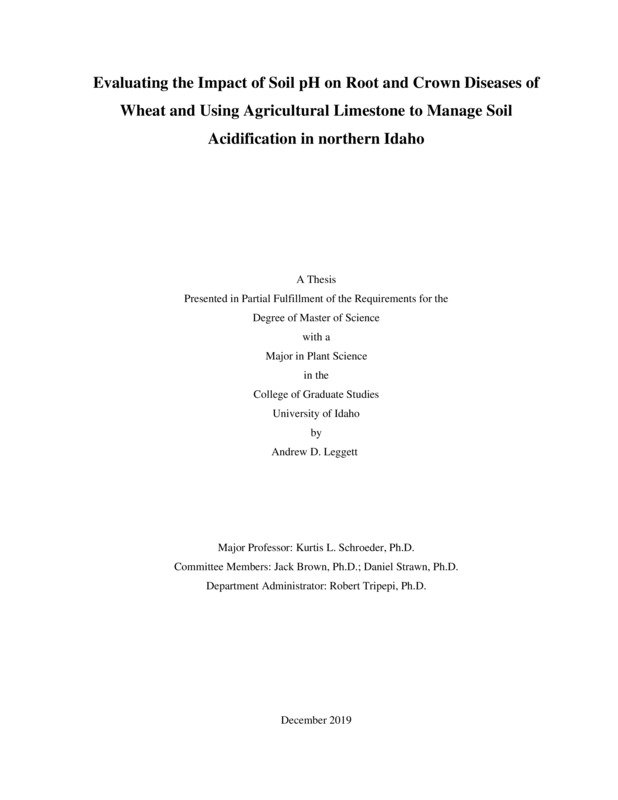Evaluating the Impact of Soil pH on Root and Crown Diseases of Wheat and Using Agricultural Limestone to Manage Soil Acidification in Northern Idaho
Leggett, Andrew Deryl. (2019-08). Evaluating the Impact of Soil pH on Root and Crown Diseases of Wheat and Using Agricultural Limestone to Manage Soil Acidification in Northern Idaho. Theses and Dissertations Collection, University of Idaho Library Digital Collections. https://www.lib.uidaho.edu/digital/etd/items/leggett_idaho_0089n_11700.html
- Title:
- Evaluating the Impact of Soil pH on Root and Crown Diseases of Wheat and Using Agricultural Limestone to Manage Soil Acidification in Northern Idaho
- Author:
- Leggett, Andrew Deryl
- ORCID:
- 0000-0002-1178-3595
- Date:
- 2019-08
- Keywords:
- Fusarium culmorum Lime Rhizoctonia oryzae Rhizoctonia solani Soil pH
- Program:
- Plant, Soil and Entomological Sciences
- Subject Category:
- Plant sciences
- Abstract:
-
Soil pH has been declining in northern Idaho, primarily due to the consistent use of ammonium-based nitrogen fertilizers. The major yield reducing factor in low pH soils is increased aluminum (Al) toxicity. Research is needed to determine the rates of lime needed to ameliorate the acidic soil and the economic rate of return for those rates. Studies were conducted in the greenhouse and field to explore the response of Rhizoctonia oryzae, R. solani AG-8, and Fusarium culmorum to increases in soil pH with liming. Results indicate that incidence and severity of Rhizoctonia root rot and Fusarium crown rot is likely to increase when soil pH increases with liming and that a soil pH value of 6 is optimal for these pathogens. A second component of the research was to establish long-term field studies in northern Idaho to explore the effect of three liming rates (2,242; 4,484; and 6726 kg ha-1) on ameliorating soil pH and examine the economic feasibility of these treatments. Trials were conducted at five locations for 2 years and all three lime rates significantly increased soil pH in the top 7.5 cm at all sites, with some sites experiencing increases in the 7.5 to 15 cm range. The increased pH was associated with significantly increased base saturation and reduced Al concentrations at all sites as well. Yields were increased with increasing rates of lime at many of the sites. Net present value was used to amortize the cost of liming over multiple years. Based on the data from this study, there was an economic benefit to liming in five of the seven site-years, with an average of $21, $26 and $39 ha-1 net returns for the 2,242; 4,484 and 6,726 kg ha-1 lime rates, respectively. Preliminary data suggests that lime application in soils with documented acidification may be economically beneficial for growers in northern Idaho.
- Description:
- masters, M.S., Plant, Soil and Entomological Sciences -- University of Idaho - College of Graduate Studies, 2019-08
- Major Professor:
- Schroeder, Kurtis L
- Committee:
- Brown, Jack ; Strawn, Daniel
- Defense Date:
- 2019-08
- Identifier:
- Leggett_idaho_0089N_11700
- Type:
- Text
- Format Original:
- Format:
- application/pdf
- Rights:
- In Copyright - Educational Use Permitted. For more information, please contact University of Idaho Library Special Collections and Archives Department at libspec@uidaho.edu.
- Standardized Rights:
- http://rightsstatements.org/vocab/InC-EDU/1.0/

